Grand nettoyage au Galion / Big cleanup at Galion
Un nouveau plan de gestion / A new Management Plan
Lancement de BioHab2 / BioHab2 Launched..
La Réserve naturelle de Saint-Martin est une aire marine protégée de 30km2 située au nord-est de l’île de Saint-Martin. Créé en 1998, cet espace préserve les cinq principaux écosystèmes de l’île : récifs coralliens, mangroves, herbiers de phanérogames, étangs et forêt sèche littorale.
Grand nettoyage au Galion / Big cleanup at Galion
Un nouveau plan de gestion / A new Management Plan
Lancement de BioHab2 / BioHab2 Launched..
A management plan, which is a regulatory obligation for all nature reserves, serves as the blueprint for the management team. This is an essential document for the organization, follow-up, and evaluation of the management of each Réserve. As the first such plan for the Réserve Naturelle de Saint Martin had expired, a second version has been drafted. The Réserve entrusted this important task to Amandine Vaslet, a doctor of marine biology.
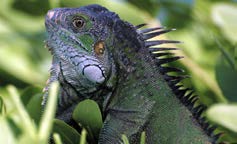 The evaluation of the first management plan proved very postitive, as 61% of the 104 items on the outline were completed, and 22 additional items were more than 75% complete. Only four items were not undertaken, including the reintroduction of the Lesser Antilles iguana, Iguana delicatissima, due to the explosion of the common Iguana iguana population, a species that is no longer protected but cannot be hunted.
The evaluation of the first management plan proved very postitive, as 61% of the 104 items on the outline were completed, and 22 additional items were more than 75% complete. Only four items were not undertaken, including the reintroduction of the Lesser Antilles iguana, Iguana delicatissima, due to the explosion of the common Iguana iguana population, a species that is no longer protected but cannot be hunted.
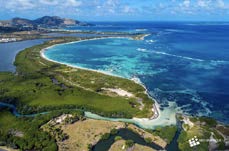
This methodology places the evaluation of defined projects at the heart of the management plan.
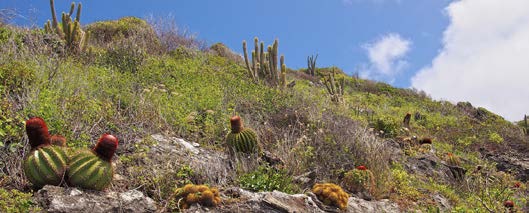
In addition to this central goal, nine other long-term objectives —compared to seven in the prior plan— were defined for the protection of our natural heritage.
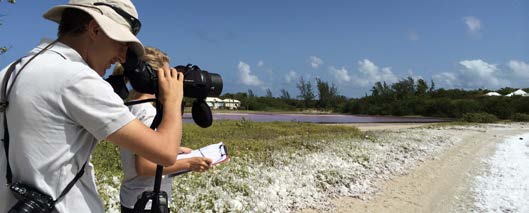
These five key factors are:
The three types of indicators:
Each action is described on a factsheet that repeats the goals of the activity: its location and its timetable, as well as the human, material, and financial means required, any potential financing, and the indicators selected for its evaluation.
A summary of the management plan can be consulted on the website for the Réserve Naturelle de Saint-Martin.
As has happened every year since 2007, the annual scientific study of reefs and plant beds took place in March 2018.
The goal is to document the evolution of the ocean floor. As usual, a representative of the nature reserve in Petite Terre and another from the Territorial Environmental Agency in Saint Barth were present, in order to help the team from Saint Martin collect underwater data at such sites as Rocher Créole, Pinel and Tintamare, as well as other sites outside of the Réserve, including Fish Pot in the Anguilla Channel. This underwater milieu seems to be less impacted than the island itself, although the coral in certain zones was damaged. However, if the physical impact seems to have been limited on the reefs and plant beds, the major shifting of sediments after Irma continues to harm them. As does untreated wastewater that is allowed to run into the sea!
BioHab2 LaunchedIn our prior edition we announced that after Irma, only 20 cinderblocks were left out of the 300 used by the Réserve to build nine “BioHab” artificial habitat structures within the perimeter of the reserve.
Even so, the project has not been abandoned and the Réserve has implemented BioHab 2, with the financial support of the French Agency for Biodiversity and the Veolia Foundation, but this time comprising two sites within the Réserve. The staff of the Réserve has created more than a dozen artificial habitats. As technical solutions already proven are once again being used, a new goal this time is to use recycled materials.
The purpose of these artificial habitats is to provide a milieu with a lot of hiding places, intended to be colonized by the many different species that had rapidly appropriated them in the first version of BioHab.
As a result, some of the debris from Irma have been repurposed and contribute to the reconstruction of our underwater biodiversity.
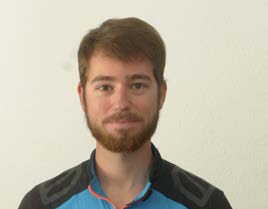
One year after her first mission in the waters of Saint Martin, Fanny Kerninon returned to the island last May. Working with the Réserve, this scientist/diver visited four plant bed stations: Grand-Case, Rocher Créole, Galion, and Tintamare. Working on her thesis at the University of Western Brittany, and in collaboration with IFRECOR, for which she coordinates the observation of underwater plant beds for Overseas France, this young woman dives into tropical waters the world over, from the Caribbean Sea to the Indian Ocean. Her goal is to produce a “tool box” for the study of plant beds and the indicators that allow managers to follow the health status of “their” plant beds, which are very different one from the next. The challenge for Fanny is to develop a set of standard tools that can be used to study all types of underwater plant beds. She also represented Overseas France at the World Seagrass Conference, June 11- 17, 2018 in Singapore.
A team of American scientists from Florida International University (FIU), including Dr. Jeremy Kizska, spent time with the Réserve as part of their regional mission. On June 18- 22, 2018 in Tintamare’s Baie Blanche, green turtles were the focus of research designed to better understand their relationship with the plant beds currently colonized by Halophila stipulacea sea grass. This invasive species was introduced via anchors and ballast water from boats, and little by little gobbled up space in the underwater plant beds, where it is now in competition with two native species: Syringodium and Thalassia. The scientists observed the location of these underwater reptiles throughout the day, as well as their activities, as they tried to identify the different algae on their menu. This study will also allow for an estimation of the size of the turtle population that visits the plant beds in Baie Blanche, and if it was impacted by Irma. The first data reported by the Réserve was that they have not found any animal cadavers at the site. The data that still needs to be thoroughly analyzed seems to mark a major change in the habits of the sea turtles in Guadeloupe, as in Saint Martin, following Irma and the other meteorological events that took place in late 2017. This study should have also allowed for the taking of skin samples into order to open the door for the first local look at Fibropapillomatosis, a herpes virus that affects certain sea turtles around the world, and the factors that trigger the risk of this disease that scientists are just beginning to understand.
The 2018 egg-laying season for sea turtles runs through November. The team of eco-volunteers tasked with walking the beaches in the hopes of seeing tracks made by a turtle that has come to lay its eggs has been reduced to about 30 people this year. Not a single set of tracks had been seen as of early June, but that is nothing to be alarmed about. In fact, at this point, no fewer than six tracks have been reported on the beaches of Tintamare, which is exactly the same number noted at the same time in 2017. Julien Chalifour, scientific director for the Réserve, will wait until the end of the season to reflect on any eventual consequences on the egg-laying habits of the sea turtles due to the disruption of the beaches by the hurricane, as well as the unusual climatic conditions.
Suzanne Gonnier, a 22 year-old student at the National Superior School for Landscape (ENSP), worked as an intern at the Réserve Naturelle in June and July 2018. A future landscape architect, she decided to come to the Réserve Naturelle to work with a leader in island management with the idea of starting her career in an environmentally protected area. Her task was to present a rehabilitation project for the Salines d’Orient, hit rather hard by Irma. The current thinking is to reconcile regeneration and conservation of the eco-systems with use by the public. Gonnier focused on the tidal reservoir, a favorite spot for nesting birds, and her recommendations comprise reconfiguring the canals in this area as well as stabilizing the banks with the planting of mangroves from the nursery created in collaboration with students from the middle school in French Quarter, as part of the Educative Marine Park program for Galion Bay. These improvements will help isolate the nesting and resting zones for the avifauna, which previously could be disturbed by terrestrial predators. These new gathering places could also allow for the development of activities such as bird watching. This work adds to the thought already given to the rehabilitation and management of this site, which is protected as part of the Réserve Naturelle Nationale with Ramsar and SPAW labels, for the richness of the eco-systems it houses.
From February 1 through May 31, 2018, the rangers of the Réserve Naturelle conducted 95 controls that were compliant to regulations, while 10 other controls proved non-compliant:
No charges were filed while the laws were repeated to the offenders.
A crew from Ushuaia TV visited Saint Martin in late January to shoot a segment on the consequences of hurricane Irma, which the producers referred to as “an unprecedented experience: climatic change”. Titled “Under The Chaos, The Beach,” the program was broadcast on Saturday June 23 and Thursday, June 28, and will remain accessible on the Ushuaia TV website. The Réserve Naturelle was called upon for the environmental section of the program. Julien Chalifour, Chris Joe, Ashley Daniel and Vincent Oliva took the video crew to Pinel, Tintamare, and Rocher Créole, aboard the boat belonging to the Réserve. They also took them under the waves, for an underwater shoot at the Remorqueur site on Tintamare.
Beautiful article by Alexis Valois and Alexis Rosenfeld in the July edition, number 449, of the magazine Ça m’intéresse. In Saint Martin after Irma, the couple went diving with the team of the Réserve Naturelle and has assessed the adaptability capacity of corals for their survival, faced with numerous external threats.
The 2017 final report for the Réserve Naturelle, its 2017 budget, and the new management plan for 2018-2027 were presented at a meeting of the Réserve’s advisory committee held on June 5, 2018 at the prefecture. Those present included prefect Anne Laubies. Nicolas Maslach recapped the activities of the Réserve in 2017—which can be found on the website of the Réserve Naturelle in prior issues of the journal—and he also revealed projects for 2018, including repairing material impacted by Irma, the creation of a nursery for exclusively local trees, especially protected species (gaïacs and melocactus intortus/barrel cactus), as well as the continued battle against pests and certain invasive species (rats, goats, common iguanas) in the natural sites within the Réserve Naturelle. Amandine Vaslet presented a detailed version of the management plan 2018 - 2027, which was created after the evaluation of the first management plan (read article page 7). The advisory committee validated the Réserve Naturelle’s final report for 2017, its 2017 budget, and its new management plan.
The managers of protected marine areas in Saint Eustatius (STENAPA), Saba (Marine Park), Saint Barth (Territorial Environmental Agency), Sint Maarten (Nature Foundation) and Saint Martin (Réserve Naturelle) met in Saint Martin during the last week of May for a technical workshop organized by the Global Coral Reef Monitoring Network (GCRNN) and the CAR-SPAW, organizations which intervene regularly with their partners. The theme of this new training centered on the technical standards for the biophysical study of coral reefs, as well as the related socio-economic elements. The question was to know how to evaluate the health of a reef and its associated species, as well as how to study the various uses —social and cultural— and economic activities that rely on the existence of the reef. One concrete example concerns the small island of Pinel and its underwater pathway, which is followed closely by the Réserve. Questions: how do the inhabitants of the neighborhood closest to Cul-de-Sac perceive this site? What activities are associated with it? And what does it mean for the economic players that have a business on Pinel? Two teams then went out into the field. The first team went diving along the underwater pathway while the second team went to meet the residents of Cul-de-Sac, as well as concerned business people. The idea of the training was to help create an approach to identify conflicts or miscomprehensions, or suggest improvements to the management of the sites, with an eye to sustainable development and a harmonization of techniques. A deeper study will take place in coming years to put the best practices into effect, and adapt them to the management of the site.
The clean-up and repairs of damage caused by hurricane Irma on sites managed by the Conservatoire du Littoral led to the creation of a strategic plan, which breaks down into four major actions. Funding comes from three sources: 80% from the French Agency for Biodiversity, the French government as part of the post-hurricane cleanup (clean-up phase for the sites), and from the treasury of the Conservatoire.
The first operation was an aerial photo shoot to obtain images using a drone, especially above the salt ponds, in order to establish the impact on the mangroves, to verify the condition of water outlets, and identify debris in the most inaccessible areas. Comparison with aerial photos taken in June 2017 provided a clearer estimation of the impact of the hurricane on these wetlands.
The second mission required the cooperation of ecologist Mélanie Haerteman and Anne-Marie Bouillé, head of the Conservatoire in Saint Martin. In March, they examined the state of fauna and flora and took hydrological measurements — temperature, oxygenation, salinity, and currents— as well as mapped the extent of debris. They covered Etang des Salines d’Orient, Etang aux Poissons, Etang de la Barrière, Etang de Chevrise, Lucas Bay pond, Etang Guichard, and they visited ponds by the airport, the cemetery of Grand Case, and the Lowlands, as well as Pinel. An information sheet currently defines the priorities at each site, actions to avoid, and those to promote. The Etang de la Barrière, where the mangrove was the hardest hit, figures at the very top of the list.
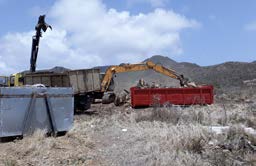 The third action got underway on July 2, 2018 with a cleanup of the Galion site. It comprised the evacuation of hundreds of tons of trash, from Club Orient and the wooden shelters from Orient Bay to metal roofing, jets ski, containers, cars, and plastic bags… The local company that won the RFP (request of proposal) for the project sent out on May 15 has just two months to remove the largest items of debris from the totality of the sites of the Conservatoire. At the same time, with the help of the Foundation of France, the back-to-work association ACED has a deadline of six months to collect the smaller trash on the same sites, and started to do so on the same day at the Lucas Bay site in Oyster Pond. In addition, one hundred French scouts are committed to cleaning up around Galion on July 14-22. They took over from 20 scouts from Belgium, who had been working at the Etang de Chevrise on July 2-13. All of the debris will be treated by the Ecosite, which donated all of its services to ACED and the Réserve Naturelle, and offered preferential rates to the local company. And with an eye toward replanting the mangrove, the Réserve Naturelle is collecting seeds for this coastal vegetation and start a nursery.
The third action got underway on July 2, 2018 with a cleanup of the Galion site. It comprised the evacuation of hundreds of tons of trash, from Club Orient and the wooden shelters from Orient Bay to metal roofing, jets ski, containers, cars, and plastic bags… The local company that won the RFP (request of proposal) for the project sent out on May 15 has just two months to remove the largest items of debris from the totality of the sites of the Conservatoire. At the same time, with the help of the Foundation of France, the back-to-work association ACED has a deadline of six months to collect the smaller trash on the same sites, and started to do so on the same day at the Lucas Bay site in Oyster Pond. In addition, one hundred French scouts are committed to cleaning up around Galion on July 14-22. They took over from 20 scouts from Belgium, who had been working at the Etang de Chevrise on July 2-13. All of the debris will be treated by the Ecosite, which donated all of its services to ACED and the Réserve Naturelle, and offered preferential rates to the local company. And with an eye toward replanting the mangrove, the Réserve Naturelle is collecting seeds for this coastal vegetation and start a nursery.
Once the sites are cleared all of debris, it will be time to repair or reconstruct the damaged structures and installations: bird observatories, open-air shelters, signage, and pathways... Please stay tuned for updates in our next edition.
On May 16, 2018, the Conservatoire du Littoral invited representatives from the French government and the Collectivité for an overview of the projects that will be run in conjunction with the Réserve Naturelle. The principal project comprises the renovation of the Galion site, for which a three-party agreement is being finalized between the Conservatoire, the Réserve Naturelle, and the Collectivité. The plan includes the creation of a parking lot, while on the beach openair shelters will be available for use by the public, as well as a snack bar. A playground for children is also on the drawing board, in addition to beach volleyball courts. The main goal is to conserve the natural aspect of the site and protect the local fauna and flora and their natural habitats.
Inaugurated in March 2018 at the Babit Point site by Anne-Marie Bouillé, head of the Conservatoire du Littoral in Saint Martin, an observation map allows the public to identify the magnificent landscapes overlooking the rolling waves of the Atlantic Ocean on one side and the surrounding hillsides on the other. The map is embedded in a table made of lava, which should resist the weather over time. This is part of the ecological and landscaping restoration project at Babit Point, led by the Conservatoire du Littoral and the Réserve Naturelle in collaboration with local residents. In June 2013, members of the Oyster Pond homeowners’ association donated a 4.7-hectare plot of land to the Conservatoire du Littoral. This acquisition was added to the purchase of a 1.8-hectare plot, bought by the Conservatoire in April 2013 from local sellers. The project started in 2014 with the demolition of a house in ruins and continued with the installation of a wooden enclosure in 2015. The next step will be the creation of a reception area for the public, as well as a botanic nature walk. The overall project was funded at 80% by the French government and 20% self-funded by the Conservatoire du Littoral, for a total of 112,231 euros.
On June 7, 2018 at the Maison des Océans in Paris, Nicolas Maslach, director of the Réserve Naturelle, participated in a French Nature Conference, organized by the French committee of the UICN (International Union For Conservation of Nature), as part of its 25th anniversary celebration. The UICN is the leading worldwide non-governmental organization dedicated to the conservation of nature. The next World Conversation Congress, which is held every four years, will be held in 2020 in Marseille. The main subjects to be presented in Marseille in 2020 were discussed with the participants. At the same time, Jean-François Sylvain, president of the Foundation For Biodiversity Research (FRB) made a presentation on the state of biodiversity around the world, which is subject to more and more pressure, which has led scientific experts to make dramatic predictions. He urged everyone to promote environmental protection and sustainable use of their biodiversity as a strategic, political, and economic priority. He also voiced an optimistic note about France, where public opinion, the business sector, and certain politicians are already thinking in this manner.
The annual overseas conference of the French Agency For Biodiversity (AFB) was held on April 9-11, 2018 in Paris. The goal was to make an inventory of biodiversity projects currently underway in all of the overseas territories, identify the expectations of these territories in terms of the AFB, and to define new modes of collaboration. For the 150 participants, this conference was also the occasion to share experiences native to their own overseas locations, such as Guyana, Reunion Island, New Caledonia, and Saint Martin, represented, of course, by Nicolas Maslach. After a presentation of the challenges in the conservation of the biodiversity in overseas territories, a dozen workshops allowed the attendees to delve into a series of diverse subjects such as the protection of coral reefs, and the ecosystems associated with economic development confronted with biodiversity conservation.
Nicolas Maslach was invited on March 29, 2018 to attend the seventh edition of the Impact2 Forum in the meeting room at City Hall in Paris. Several themes were on the agenda, ranging from social economy and solidarity to ecology, durable development, and artificial intelligence. Anne Hidalgo, mayor of Paris, opened the Forum before giving the floor to esteemed participants, including minister of ecology Nicolas Hulot, deputy and mathematician Cédric Villani, president of the Olympic Committee Tony Estanguet, and astronaut Thomas Pesquet. Close to 50 islands and countries were spoken for—including Saint Martin—by one thousand representatives. Impact2 is organized in Paris every year by INCO, the first worldwide consortium for a new economy that is green and sustainable.